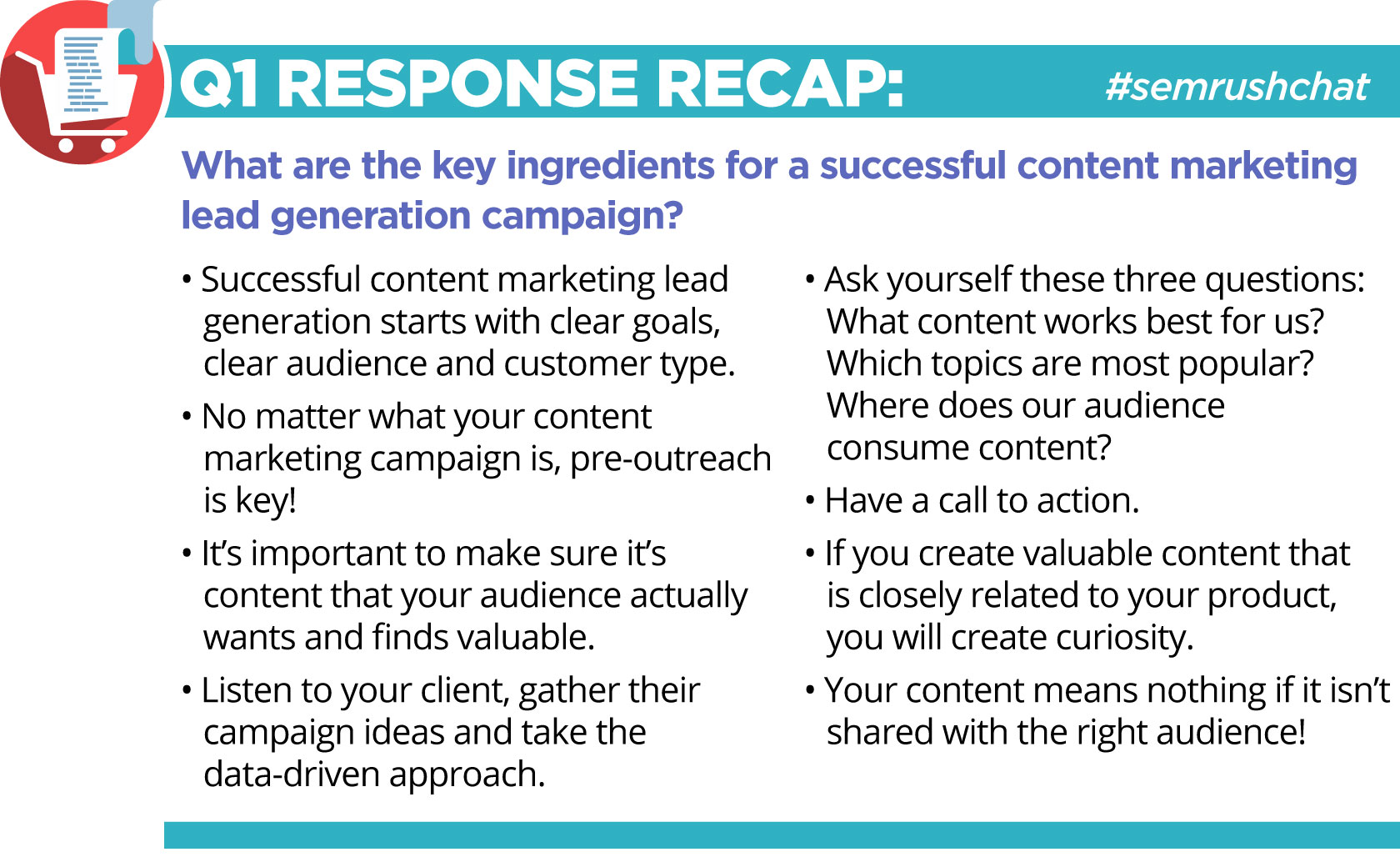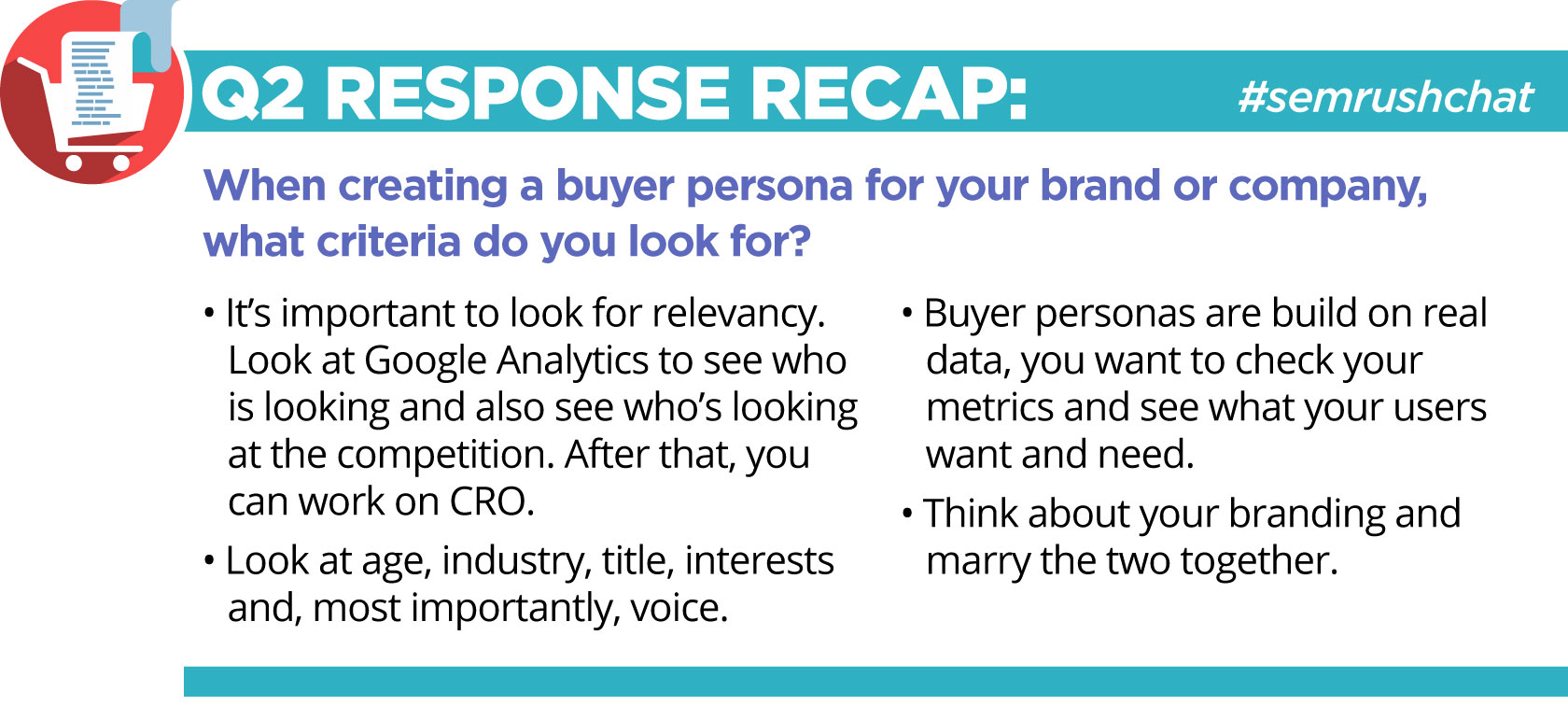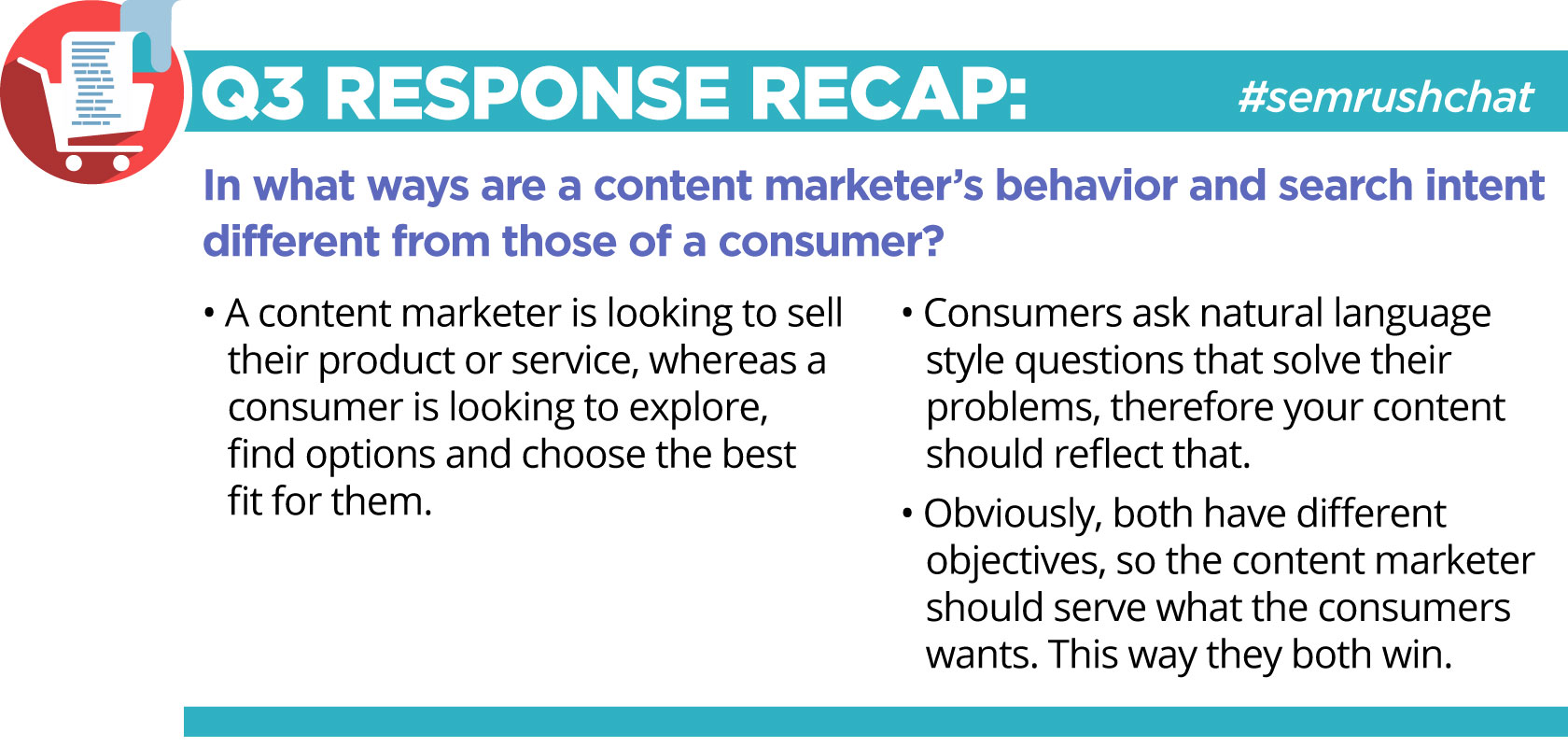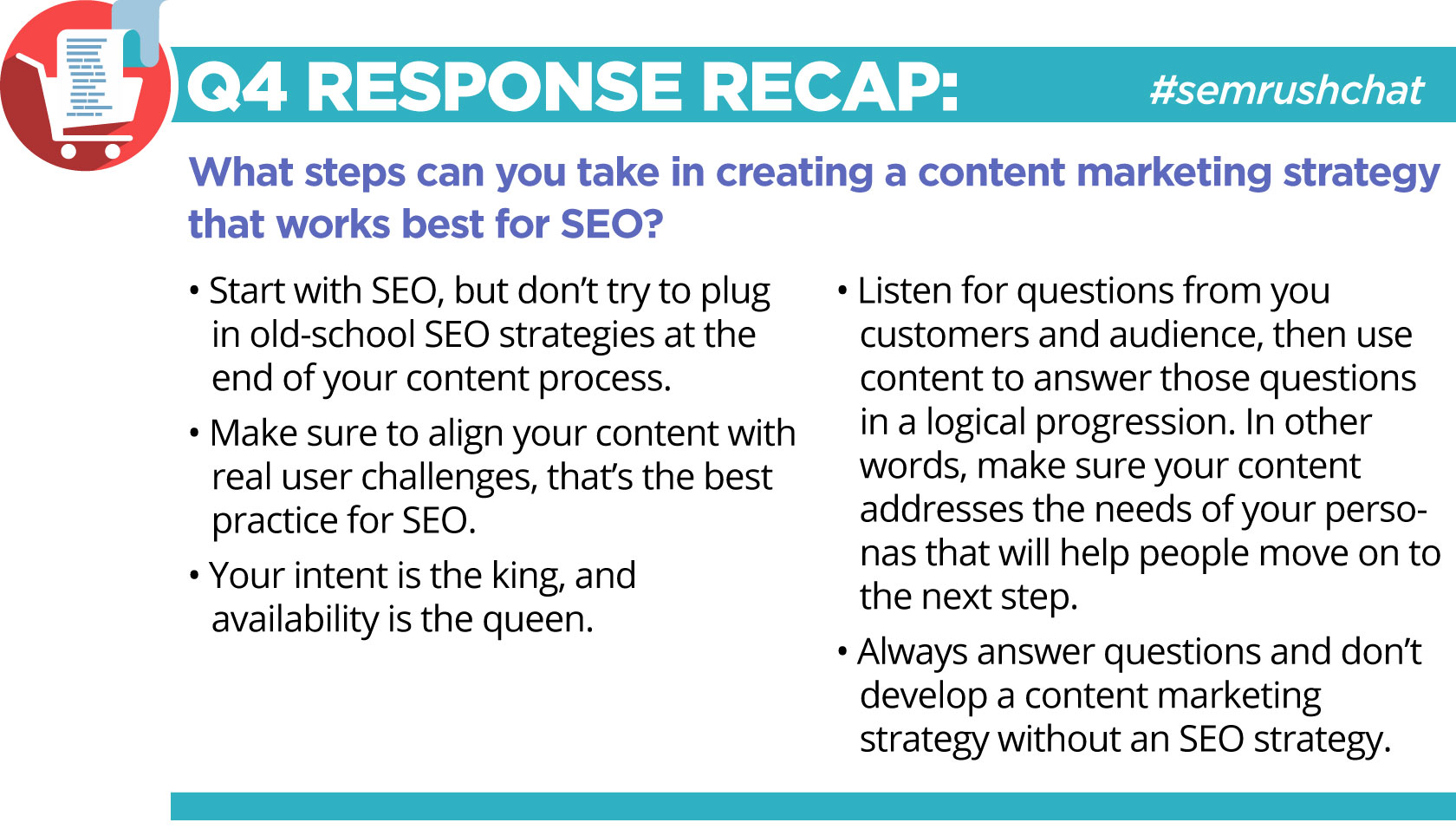Online search has changed the game.
You can no longer acquire new clients by simply reassuring that your product is the best on the market. These days, if a modern consumer needs to decide whether or not your product meets their needs, they can find everything they want to know online, including characteristics, reviews, ratings, prices, and competing products.
Before becoming a customer, a person first goes through several stages when considering a purchase. Strategically thinking content marketers need to create content that can deliver information that their prospects need, before they need it. This helps your customer to move from one stage of the buying process to the next. This is why understanding the buyer’s journey is critical to a successful content marketing campaign.
During our latest SEMrush Chat, we discussed how to align your content marketing strategy with the buyer’s journey with special guest, Mike Allton. Mike is a Content Marketing Practitioner, an Author, an Award-Winning Social Media Blogger, Editor at The Social Media Hat, and the Chief Marketing Officer at Solo Build It!. With the help of our guest and attendees, we came up with some great ideas on how to plan your strategies to attract and convert more customers on your website:
Q1. What are the key ingredients for a successful content marketing lead generation campaign?
If done right, content marketing can be a powerful tool for generating leads, but, it’s easier said than done. These seven steps can help you to do it right:
1. Use a data-driven approach
Great content is not limited to creativity only. A key component of a successful content marketing campaign is data. Data can help you to identify your target audience, their relevant topics, and channel the preferences of your potential buyers. By incorporating the following post-campaign metrics you can get wealth of valuable information:
Engagement rate. Are your site visitors interacting with your content?
Conversions. Did people go to other pages of your site? Did they download a piece of content or sign up for your newsletters?
By taking a data-driven approach, you’re able to better understand your audience and their intentions.
a1) Data-driven approach. WHat content types convert for us? What topics are popular? Where does our audience consume content? #semrushchat
— Ryan Johnson (@rsj8000) April 12, 2017
2. Invest your time and efforts in pre-outreach
Strategic thinking is key when it comes to creating content. While pre-outreach can be complex, it’s a very important process that can help you to create content that is both interesting to your audience and relevant to your brand.
Before you create and publish your content, you must first invest your time and efforts in communication. This means building sustainable relationships with publishers and journalists, as well as niche bloggers and community newspapers that usually have unique connections to your audience. It’s important to research your audience by figuring out their content consumption and their sharing habits
Q1: for any CM campaign, pre-outreach is key! validate w/ industry, peers & audience before building anything. #semrushchat
— Bastian Grimm (@basgr) April 12, 2017
3. Make sure your content is high-quality, valuable, and relevant
A successful content marketing campaign is based on data-driven and high-quality content. You need to demonstrate your expertise and establish authority to gain your audience’s trust and loyalty. “Quality and uniqueness of content — don't just build another shitty infographics. Combine formats for best-in-class UX,” tweeted Bastian Grimm.
@semrush a1) Create valuable content closely related to your product, creating curiosity. A good CTA will finish the job. #SEMrushchat
— Lucas Vos (@lucasvos) April 12, 2017
4. Pay attention to context
The digital landscape has changed. The days where having just great content are gone, you need to know how, where, when, and who you should be delivering it to. More than ever, modern consumers are expecting brands to provide information that they need at the most relevant moments in their buyer’s journey.
Aside from producing quality content, you should:
Know the audience that you’re talking to, including their wants, needs, motivations, and pain points.
Figure out the right moments your users are likely to be most interested in your message.
Understand where your potential customers are spending their time (e.g., specific social media networks).
A1. Context. If you're going to get them to convert into a lead, you need to speak to their emotional drivers, not just KWs. #SEMrushchat https://t.co/xIVDc2UvFU
— Matt Lacuesta (@MattLacuesta) April 12, 2017
5. Understand different stages of the buyer’s journey
There are several factors that determine the stages of the buyer’s journey such as your industry, product or service, pricing, business model, and audience. However, it is typically categorized in three stages:
Awareness. Your potential customer is becoming aware of a need or a problem.
Consideration. Once your potential client realized a particular need or pain point, they begin a research.
Decision. Now that your prospective is aware of the problem and a solution to it, they’re going to select between different vendors.
As a content marketer, your job is to understand the difference between these stages and produce content for audiences on each of these stages.
A1: understanding the different stages of your funnel and creating engaging content for that audience #semrushchat
— Danny Ray Lima (@dannyraylima) April 12, 2017
6. Create a content distribution plan
No matter how great and data-driven your content is, you still need a solid content distribution plan. An effective distribution strategy will help you put your message in front of your audience and build a stronger relationship with them.
You need to define your business goals, your target audience, and your consumers’ behavior. Once that is defined, you can use that to choose the which distribution channel is right (i.e., SEO, PPC, native advertising, social media, etc.) and plan your distribution content strategy accordingly.
A1. key ingredient is a great content distribution plan. Your content means nothing unless it's shared with the right audience #semrushchat
— Olga Andrienko (@Olgandrienko) April 12, 2017
7. Integrate engaging social media activity
Social Media networks provide plenty of opportunities to make your existing content more visible and searchable, especially because you are able to customize your content for each. For example, you can post articles on LinkedIn and Facebook, put PowerPoint decks on SlideShare, upload videos on YouTube, and post photos on Pinterest, Flickr, and Instagram.
A1 1. Know your audience (persona) 2. Targeted offer 3. Relevant content 4. Engaging social activity #SEMRushchat
— Mike Allton (@mike_allton) April 12, 2017
Our chat participants shared many great tips for developing a successful content marketing lead generation campaign. Check out a few other answers in the following recap!

When implemented properly, these key ingredients can help you to generate leads.
Q2. When creating a buyer persona for your brand or company, what criteria do you look for?
HubSpot offered a clear definition of the buyer persona: “a semi-fictional representation of your ideal customer based on market research and real data about your existing customers.” This representation of your ideal customer is critical to a successful marketing campaign. However, creating a buyer persona is easier said than done. If you’re not sure where to start, use the following criterias to ensure you’re doing the right thing:
Demographics
A good place to start is to collect demographic data to gain a better understanding of your customer: “Age, gender, marital status, occupation, interests, other products/services possibly purchased/used, and geographic location,” tweeted Corey @CoreyW85.
A2 Demographic data is nice if it’s really applicable, but it’s often better to focus on specific issues that you solve. #SEMRushchat
— Mike Allton (@mike_allton) April 12, 2017
Psychographics
An ideal buyer personal encompasses things like interests, reasons for buying, and concerns. Therefore, you need to get their psychographic profile. To better understand what psychological traits your personas possess, figure out your persona’s reason for purchasing from you and their concerns when buying your product or service.
A2: The Name of the Game is Demographics, Psychographics and Geographics #semrushchat pic.twitter.com/BnVcUxgn0x
— Nema Associates Inc. (@NemaDesignInc) April 12, 2017
Main problems
Express your buyer persona’s main problems. The more specific terms you use, the better. Focus on the nuances that can describe how these problems affect your target audience’s day-to-day life and make them feel.
A2: Look beyond segmentation and demographics. What are their issues and how do you make life easier or make them better? #SEMrushchat https://t.co/ariiRmz3ql
— Matt Lacuesta (@MattLacuesta) April 12, 2017
Specific goals and challenges
What is your persona’s primary goal? Knowing this information will help you to understand what you can do to help them achieve their goals and overcome their challenges. As with the problems, you need to make the persona’s goals specific. Broad goals are difficult to work with, because you cannot use things like “increase subscribers” to create relevant content.
A2: Outside of using real data from GA like demo, and age, define their goals and challenges you want to address #semrushchat
— Danny Ray Lima (@dannyraylima) April 12, 2017
The more specific you are, the higher the chances that you can generate content that will address your audience’s pain points and grab their attention.
A2: You need to make sure your buyer personas are specific enough that your content brings in qualified leads not just anyone. #SEMrushchat https://t.co/b2MVDBnB3r
— Annaliese Henwood? (@MktgInnovator) April 12, 2017
To find out more on the topic, you can check out the complete guide on how to research and create a content persona for your blog by Olga Rabo.

Take the time to learn more information and define your buyer persona to gain better understanding of your actual customers and ways to effectively communicate with them
Q3. In what ways are a content marketer’s behavior and search intent different from those of a consumer?
The content marketing landscape continues to evolve and there is far more that goes into content marketing than just content itself. There have been many talks about content strategy and specific content types, but it’s what’s more important is how you implement content in your overall marketing campaign.
The truth is, content marketing isn’t about content. Aaron Agius points out that content marketing is all about maintaining or changing consumer behavior. But what is behind a content marketer’s behavior? How does a content marketer’s behavior and search intent differ from those of a consumer?
Marketers and consumers have different objectives. However, the content marketer’s goal is to find out what their consumers want and serve their needs. “Hopefully the marketer's behavior and intent is to discover the user's behavior and intent,” tweeted Nate Dame @seonate.
A3: Obviously both have different objectives, but the content marketer should serve what the consumer wants so they both win. #semrushchat
— Rachel Howe (@R8chel_Marie) April 12, 2017
Arnout Hellemans @hellemans said that content marketers should be searching the same way as a customer to spot gaps in their content. However, most of them don't do so. To generate effective pieces of content, marketers need to understand the current state of their content and plan a strategy that will aim at meeting the needs of the buyer. It’s important that your content be more closely aligned with those needs.
@semrush A3. Content marketers search for gaps to fill with content. Consumers search for the content we fill those gaps with. #SEMRushChat
— PureFocus (@PureFocus) April 12, 2017
An incredible amount of digital content is produced today. Thanks to the Internet, information has become much more available than it was a few decades ago. Nevertheless, when it comes to content marketing, 70% of marketers lack a consistent or integrated content strategy.
A3: Real people don't automate. Also they are overwhelmed by huge amounts of content. People seek solutions not content. #semrushchat https://t.co/bE7qAMpn3I
— Tadeusz Szewczyk (@onreact_com) April 12, 2017
Jay Acunzo describes three key behaviors behind creative content marketers. One of them is the ability to empathize with their audience. That means that a creative, professional content marketer can share users’ feelings and learn their experiences. This ability helps content marketers to better understand what their consumers really need.
Acunzo recommended to constantly consume your own content to answer the following important questions: “Am I living my content or just creating it?” and “Am I talking to customers or just my teammates?” By doing so, you can witness your work the same way your site visitors see it
When consumers are searching, they’re looking for solutions to the problems that bother them. The greater your empathy for your consumers, the better you can answer their questions and produce content that offers the best solutions:
A3: Consumers are asking natural language-style questions that solve their problems. Content should reflect the ask. #SEMrushchat
— Maureen Jann (@MaureenOnPoint) April 12, 2017
By creating content that builds emotional connections with your audience, and provides the user experience they’re looking for, you can earn their trust and develop long-term relationships with your consumers.

It’s true, content marketers and consumers have different challenges and goals, however, it’s important to note that content marketers can influence a consumer’s behavior by providing them with content that appeals to their feelings and serve their specific needs. This way, both parties will win.
Q4. What steps can you take in creating a content marketing strategy that works best for SEO?
The biggest challenge is to successfully combine these two elements. Our chat participants shared five effective ways to develop a content marketing strategy that works best for SEO:
1. Learn from your audience
Smart marketers don’t simply tell their audience what to do, instead, they try to learn from them first. By listening carefully to your consumers, you can better understand their needs and wants to strengthen your further efforts.
The best way to get valuable information about your consumers is to start by conducting surveys. This helps you to collect genuine feedback from your brand’s audience that will help you to better understand what they really want. Pay attention to what they ask and what bothers them. The more information you possess about your audience, the more effective content you can produce to properly answer their questions and help them move to the next step of the buyer’s journey.
“An effective content marketing strategy reveals insights your target audience is curious about learning more of,” tweeted Bill Slawski @bill_slawski.
A4 1. Listen for questions from your customers & audience 2. Use content to answer those ?s in a logical progression #SEMRushchat
— Mike Allton (@mike_allton) April 12, 2017
2. Think topics — not keywords
This doesn’t mean that you shouldn’t care about keywords at all. Instead, it means that a proper usage of your best keywords is still a very important element of a well optimized webpage. However, when developing your content strategy, start with user research. The point is to choose the right topics and focus what will answer your user’s questions, not just to have content with the most keywords.
Find what your audience is searching for and what search queries they are using. Try to figure out what common questions they have, when they first searching for a company like yours:
a4) How do people search related to your products; questions, competitors, answer sites. Optimize for topics, not keywords. #semrushchat
— Ryan Johnson (@rsj8000) April 12, 2017
To best optimize your content for SEO, read Nate Dame’s 77-item checklist. In this checklist, he points out that once you know what queries your audience is using, you can craft your content strategy to answer their specific questions.
3. Don’t leave SEO too late
SEO is still important. If you want to maintain visibility and get traffic to your website, you need to rely on it. SEO helps to get your content found by allowing you to use the right terms. A content writer who pays attention to SEO considers site architecture and how the site is guiding the visitor through the discovery process. Therefore, when starting your content process, start with SEO, don’t end with it. “Fight to be part of the process at all stages! In many organizations, strategies are developed before SEO is considered,” recommended Matt Lacuesta.
It’s important to note that Google and other search engines are updating their algorithms often. This means that that you need to change your SEO campaign over timeand clean up any old optimization techniques that may not be relevant.
A4 First, START with SEO ... don't try to plug in old school SEO "strategies" at the end of the content process. #semrushchat
— Nate Dame (@seonate) April 12, 2017
4. Ensure your content and SEO teams work together
Continuing from the last point, if you want to make your content marketing and SEO strategy work together, you need to effectively combine these two elements. The success of your content depends on SEO, and vice versa. Your content team should be able to write with a knowledge and a clear understanding of SEO goals, which includes headline optimization, use of the right keywords, and other tactics. In turn, your SEO team needs to work with content marketers to help them set and achieve the right content goals. “Your SEO team should train your content team on a data-driven approach. Too many think of SEO as sticking in keywords at the end,” tweeted Ryan Johnson.
A4: I'd advise an all hands-on-deck meeting with content + SEO teams. Does everyone agree on goals, objectives? Start there. #SEMrushchat
— Kathleen Garvin (@itskgarvin) April 12, 2017
5. Don’t be afraid to try new things
Finally, stay fresh and don’t be afraid to try new things, including new content, new tactics, and new tools. Thinking outside of the box may sound cliche, but if you’re approaching your strategies in new and innovative ways, you’re more likely to keep your audience excited and, in turn, coming back to your site more and more.
Content marketing is constantly evolving, therefore, you need to evolve as well. Try to think about creative content marketing ideas to trigger your business growth, invest your efforts in producing a new wave of worthwhile and creative content that can capture attention, trigger imagination, nurture interest, and drive decision:
A4: It is really important to think outside of the box and be willing to try new things to increase your content marketing. #semrushchat https://t.co/dGg1w7TO1r
— Maria G. (@mariacgeb) April 12, 2017
Let’s sum up!

Keep the tips from this post in mind to develop a content marketing strategy that will help you increase engagement and maximize conversions.
We would like to thank Mike Allton and our other chat guests for sharing their expertise and great insights!
Innovative SEO services
SEO is a patience game; no secret there. We`ll work with you to develop a Search strategy focused on producing increased traffic rankings in as early as 3-months.
A proven Allinclusive. SEO services for measuring, executing, and optimizing for Search Engine success. We say what we do and do what we say.
Our company as Semrush Agency Partner has designed a search engine optimization service that is both ethical and result-driven. We use the latest tools, strategies, and trends to help you move up in the search engines for the right keywords to get noticed by the right audience.
Today, you can schedule a Discovery call with us about your company needs.
Source:




![How To Create a Strategic Dashboard in Excel Using Semrush Data [Excel Template Included]](https://allinclusive.agency/uploads/images/how-to-create-a-strategic-dashboard-in-excel-using-semrush-data-excel-template-included.svg)
